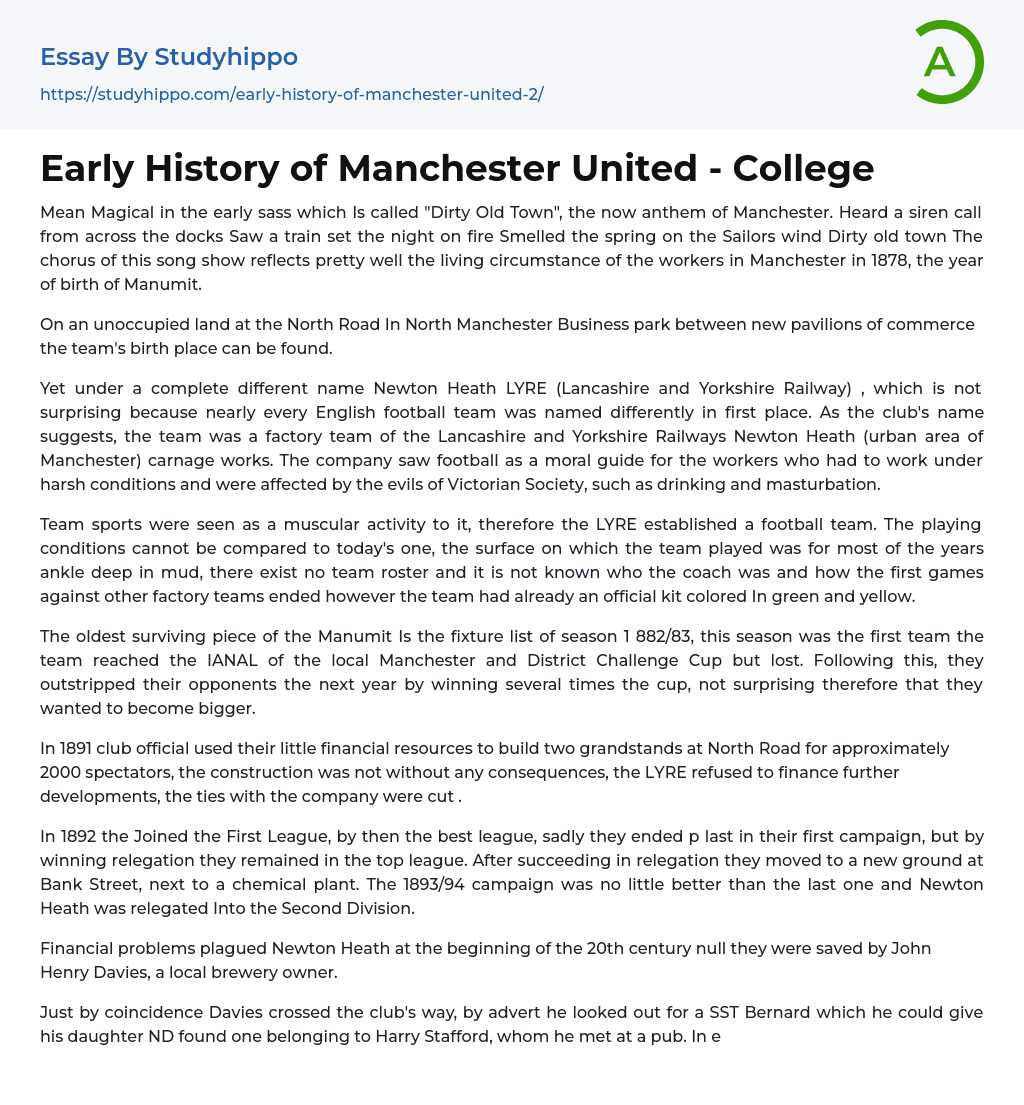

Early History of Manchester United – College Essay Example
During the early 1900s, "Dirty Old Town" or Mean Magical was a popular anthem for Manchester, describing witnessing a train setting fire to the night and smelling spring on sailors' wind across the docks. The chorus reflected living conditions of workers in Manchester in 1878, which is also when Manumit was founded. Newton Heath LYRE (Lancashire and Yorkshire Railway) was initially established on unoccupied land at North Road in North Manchester Business Park under a different name as a factory team for Lancashire and Yorkshire Railways Newton Heath's Carnage Works. Football was believed to serve as a moral guide for workers facing difficult conditions and social evils such as alcohol and masturbation. Despite challenging playing conditions like ankle-deep mud, no team roster, an unknown coach, and unclear game outcomes against other factory teams, LYRE already h
...ad an official green and yellow kit. The oldest surviving piece of Manchester United history is the fixture list from their 1882/83 season where they reached but lost in the final of the local Manchester and District Challenge Cup.In the year following their multiple cup victories, it was unsurprising that Manchester United sought continued growth. To this end, in 1891, club officials made the decision to construct two grandstands at North Road capable of seating about 2000 spectators. Unfortunately, this move had negative consequences: LYRE refused to fund any further development and cut ties with the club. Despite these setbacks, Manchester United joined First League in 1892 - then considered the top league - although they finished last in their first campaign. They managed to remain in the top league by winning their relegation battle before moving to Bank Street
a new ground located next to a chemical plant. However, Manchester United's performance during the 1893/94 season was no better than their previous one and resulted in them being relegated into Second Division.
At the turn of the century, financial troubles threatened Newton Heath's future until local brewery owner John Henry Davies came to its rescue. By chance, he discovered the club while searching for a St.Bernard dog for his daughter and met Harry Stafford at a pub who happened to be its owner and liked Davies' chosen dog.They subsequently made an agreement wherein Davies invested in exchange for ownership of said dog; while not confirmed as factually accurate,this story is credited with saving Manchester United from bankruptcy.Davies changed Newton Heath to Manchester United, providing a fresh start at Bank Street. Ernest Mangnall became their first manager in September 1903, marking a new era. After being relegated for 12 years, United was promoted back to the First League at the end of the 1905/06 season. Billy Meredith's signing from rivals Manchester City helped United win their first League title in 1908. By lending ?60,000 in 1909, they moved to Old Trafford where better playing conditions were available with changing rooms and showers after matches. Prior to World War I, United had less successful campaigns and avoided relegation by one point. The war caused player losses that were not recruited. Between wars, financial and sports performance declined but they returned after a four-year gap due to war. Relegation followed in 1922 after winning only eight out of 42 matches but later recovered with promotion. The death of John Henry Davies led to deteriorating finances almost resulting in
bankruptcy in 1927 for Manchester United.James Gibson, who was a manufacturer of army uniforms, invested ?30,000 and took over the club's finances in order to rescue it from financial ruin. The team had hit rock bottom during the 1933/34 season where they narrowly avoided being relegated into the third division but managed to make a comeback two years later. Their debt peaked at an unprecedented amount of ?70,000 prior to World War II. Despite Old Tradeoff being taken over as a military depot during the war, football games were still played there. Although Luftwaffe had targeted Ere stadium repeatedly throughout World War II, it remained partially intact and Manchester United continued playing their "home" games at Maine Road - their rival Manchester City's stadium.
- Russian Empire essays
- Ancient Greece essays
- British Empire essays
- Historical Figures essays
- Nazi Germany essays
- Roman Empire essays
- War essays
- Revolution essays
- 19Th Century essays
- Historiography essays
- History of the United States essays
- 20Th Century essays
- World History essays
- Vikings essays
- Declaration of Independence essays
- Civilization essays
- Evidence essays
- Genocide essays
- Colonialism essays
- Rebellion essays
- 1960S essays
- 1920S essays
- 1950S essays
- Letter from Birmingham Jail essays
- Louisiana Purchase essays
- The Columbian Exchange essays
- World Hunger essays
- What is History essays
- Bravery essays
- Gilded Age essays
- Vladimir Lenin essays
- Alexander The Great essays
- Sparta essays
- Victorian Era essays
- Henry v essays
- Stonehenge essays
- Frederick Douglass essays
- Mahatma Gandhi essays
- Joseph Stalin essays
- Geert Hofstede essays
- George Eliot essays
- Ginevra King essays
- John Keats essays
- Siegfried Sassoon essays
- Ben jonson essays
- Billy elliot essays
- Wilkie collins essays
- John Proctor essays
- Harriet Tubman essays
- Napoleon essays



